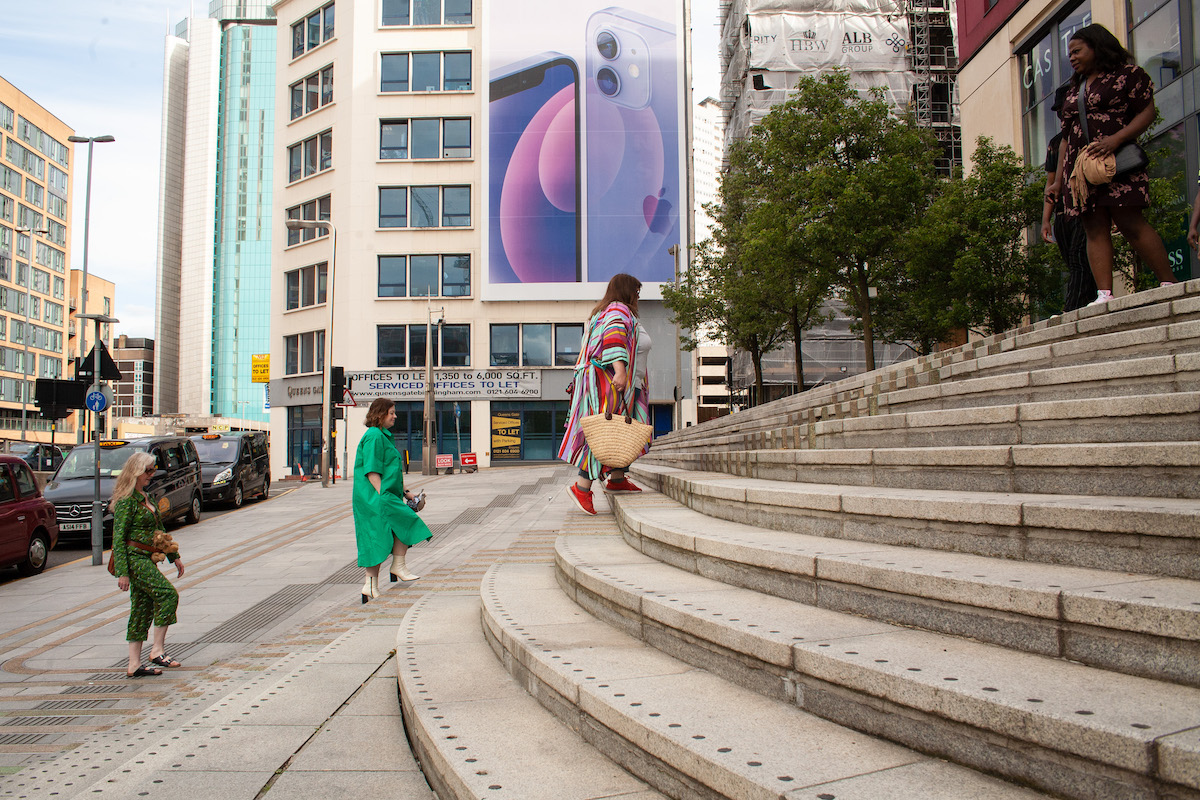Liz pauses us as we emerge onto the terrace above the canal. All around is a social throng of teens, twenty-, thirty- and fortysomethings. They line the floors of the Mailbox, drinking, dining, flirting, peacocking and people-watching. After months of restrictions, the UK's third lockdown is easing and it’s a beautiful sunny Saturday evening in central Birmingham. The mood is celebratory. The olds are mostly vaccinated, the young at least partly so, and everything feels just a little bit more hopeful for the future. Humanity is in its brightest colours.
This is either going to be the most triumphant or the most uncomfortable part of our attempt to ‘crone the city’.
==
Croning the City
Who are these women? Are they important in some way? Why are they carrying stuffed toys? Why are they walking in a line? Why is a photographer snapping them? Where did the middle one get that dress? What is the story here?
Three crones walk in silent, single file.
The crones walk through city infrastructure that can feel forbidding to all women – underpasses, canal towpaths and tunnels.
The crones walk where women of their age wouldn’t ordinarily be present – past strip-club streets to the party zone on a Saturday night.
The crones walk where they are most visible – across sweeping bridges and staircases, through a train station, a high-end mall, past tables of people-watchers.
The crones are dressed in bright colours. Two carry props of toy animals. They walk in a resolute but unhurried fashion.
A photographer trails them, running ahead, to the side, crouching into position to frame the women against the city.
The crones are glanced at, stared at and the subject of both whispered comments and open exclamations… They are also frequently not noticed at all.
The crones appear briefly on a hot Saturday night in the city and just as quickly fade away, leaving only small, temporary traces in the lives of others.
==
Can we do a watched walk?
“I was thinking about [how women walk] and wondered if we could do a watched walk? How could we encourage the most people to have a memory of us walking through a city?”
– Liz
Six weeks before the Crone Walk, I posted a photo from my second all-female Dazzle Walk – a walk designed to make us digitally invisible to the city’s prevalent surveillance cameras. The murder of Sarah Everard was causing widespread outrage and factoring into post-Dazzle Walk discussions about how women walk. How did being invisible in the city make us feel. Safe? Threatened? Subversive? If cameras didn’t protect us, what would? More female pedestrians? Walking with others?
I invited female friends to join me on a series of walks together in the city, perhaps alternating on the themes of visibility/invisibility. Those who volunteered were 40 and 50-year-olds, the age when women tend to become invisible and less valued within a society that favours youth and patriarchy. Age, gender and visibility quickly became a factor in this next walk.
Having spent a year thinking about walking invisibly – on Dazzle Walks, Dark Moon Walks and Night Hikes – walking with the sole purpose of being seen seemed an interesting counterpoint. What might the opposite of an invisibility walk look like? How could we as deprioritised older women become visible again?
==
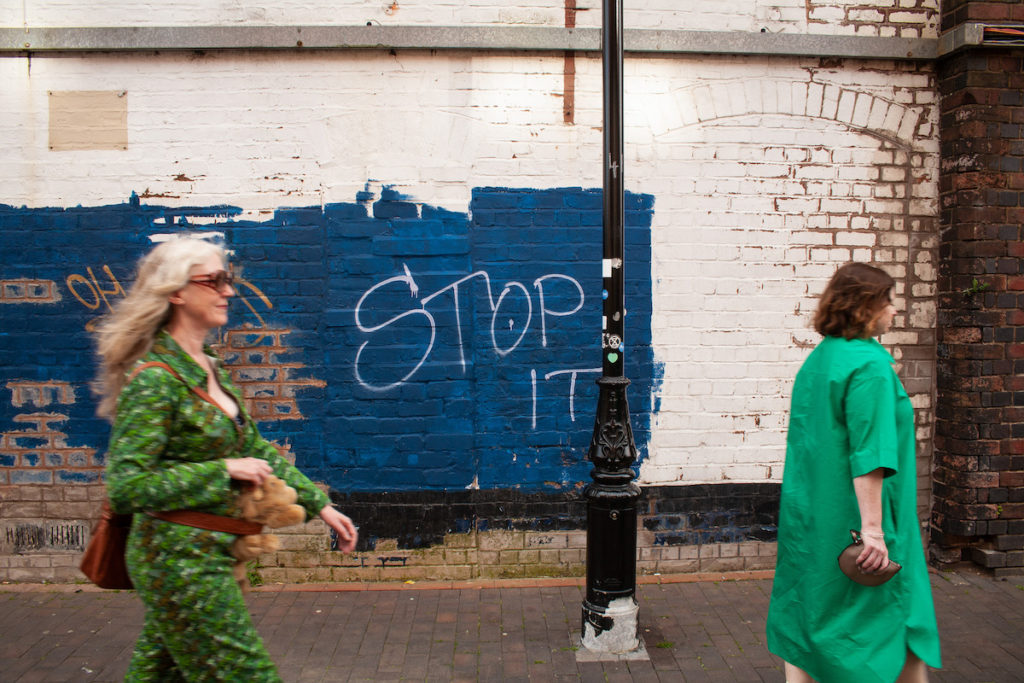
At New Street Station, the photographer (Matt Murtagh) is documenting the walk at our request. He takes some pre-walk photos as a warmup and we present ourselves one by one for the camera.
Our self-generated poses mimic those of fashion models, cougars and various other female stances selling desirability. As a middle-aged woman who is none of those things, they nevertheless rise up in my mind. I want to look attractive – this is how I perceive that to happen. It’s what we see everywhere in advertising and women’s media – women bent into weird accentuating shapes. These images are culturally embedded and inescapable. And so at home, we drop a hip, or stick out a foot, or position our bodies in some way that is deemed to be more attractive than simply standing still. It’s what we know.
We submit to our close-ups but it feels awkward, perhaps because it foregrounds our struggle with the desire to look good for the camera. We trust Matt and yet we are fighting a culture that says we must look younger, thinner, happier, prettier, sexier. I feel tension between this and my crone-aged self. I want to be authentic yet here I am posing and breathing in the middle-aged spread.
==
On ageing in a patriarchy
“… I feel at my most confident now … I am more myself … more powerful now that society has decided I’m less useful … No one says thanks or recognises us … At the mercy of my hormones … I’m angrier now the oestrogen has gone … We are all knackered … I’m worried about losing my desire/desirability … I’m happy to be less visible …”
– Snippets from pre-walk discussions
The experience of ageing is different for men and women. For women, the menopause draws a distinct line based on our reproductive organs shutting down. With it comes a hormonal rollercoaster with 30-40 recognised symptoms that may go on for a decade. At 53, I’m two years in and there is no ignoring the pile up of symptoms, which can be mild or debilitating from one day to the next.
The traditional maiden, mother, crone archetype provides a neo-pagan view of the different life stages of women. I’ll be honest, it isn’t an area I’m familiar with, unless the archetype can also mean tomboy–careerwoman-other. I viewed ‘crone’ with as much suspicion as all the other labels and cultural stereotypes that afflict women throughout their lives – as yet another put-down.
Crone feels like the most loaded word of the archetype. Images of witchy Baba Yaga, fairy godmothers and old hags in rags immediately spring to mind. But crone archetypes also symbolise ‘wise women’, finally able to take a step back from the concerns of maidenhood and motherhood and enjoy a potentially very different, transformative ‘third act’. My own mother is an example here, transformed from shy Irish maiden to immigrant mother-of-three to founder of the Acorns Children’s Hospice shops (From Little Acorns…).
With age can come wisdom and growth. This is a theme of our pre-walk chats. The crones discuss how much more confident we are in many ways now that we are older. Our knowledge and experience makes us more powerful in our work, more confident in our sexuality, and more articulate in our voice and expressions.
Yet in a youth-oriented patriarchy, we are also now more likely to be overlooked, less likely to be listened to, passed over for work or jobs, and seen as less desirable or less valuable somehow due to age. The unspoken biological question surfaces: what do we have to contribute to society now that our reproductive work is done?
==
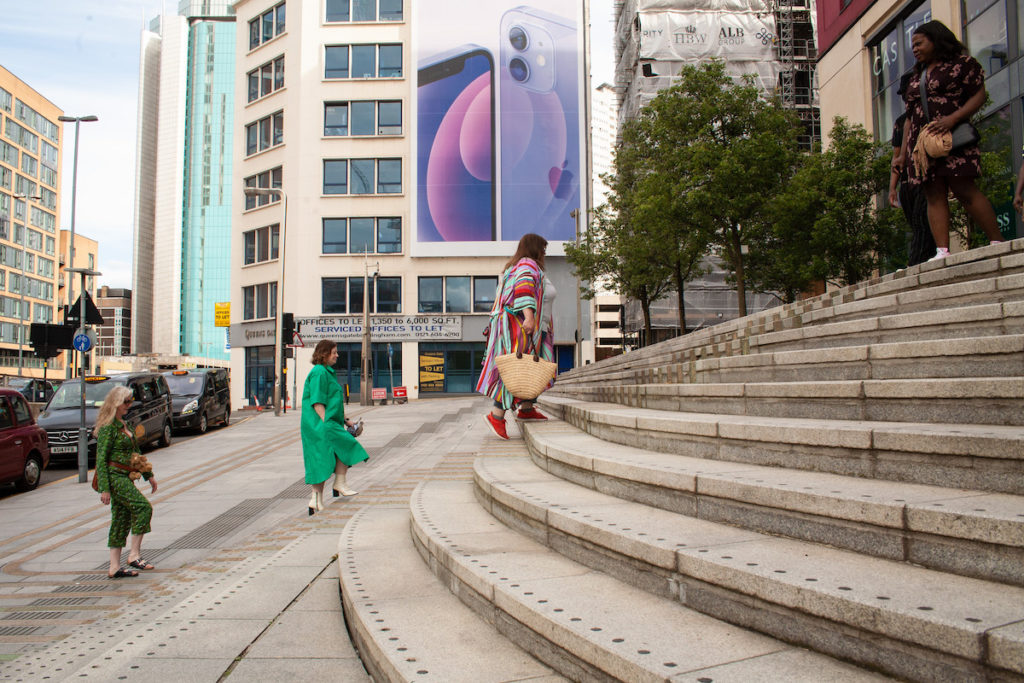
People are giving us plenty of side-eye as we pass them on the pavements near New St Station. We are not walking ‘normally’. We are in single file and slow but purposeful. At the Hill St crossroads, we stand juxtaposed next to three maidens, waiting for the green light. All of us are dressed up but our older bodies are more lived in, our middles way less defined, our outfits less figure-hugging. We are the same but 30 years in the future. I try to think of somewhere our generations interact without the power relationships of age: parent and child, teacher and student, line manager and employee. Nothing comes to mind.
We reach The Mailbox. A huge former Royal Mail sorting office, now a destination for high end goods and services. There is a sense of us rising up. We emerge from a concrete underpass up a sweeping stone staircase, then escalators, then lifts. The situation also feels heightened – we are about to enter the entertainment district.
A couple of expensively-dressed young women look up briefly from their drinks. I feel assessed. I don’t think we look old so much as out of place. Not thwarting expectations of ageing so much as thwarting expectations of what we should be doing in that space. “What are we doing here if not shopping?” asks Liz in her route prompts.
==
How do you perform ageing?
"He said: ‘Ah you know a woman's middle-aged when she's wearing leopard.’ The casual sexism and ageism of that comment has stayed with me for 12 years”
– Jenny
“… [Ageing] is a multiple, ambiguous and contradictory process which provides us – continuously and simultaneously – with images of our past, present, lost, embodied and imagined selves”
– Helene Moglen, Aging and Trans-aging, Bodies in the Making
The Crone Walk had a sense of occasion, a ‘happening’. Pre-walk, it felt as if we were preparing for any night on the town. We discussed dress codes for greater visibility but instead of little black dresses and heels, the talk was of robes that made us look like cult leaders, or functional boiler suits, or “something with a leopard-esque print” that plays into the everyday sexism and ageism of cougar/MILF/GILF sexual stereotypes.
We talked of challenging these stereotypes but also of lost or alternate or potential selves. Dressing up for the walk could be part of the process of ‘becoming’ this other self.
Accessories included comfortable walking shoes and props such as stuffed toys (hinting at eccentric cat lady and megalomaniac villain stereotypes, roles we were over-associated with or that were associated with men).
The female ritual of ‘getting ready’ felt familiar to our younger selves. The fun, the anticipation, the mirror checks – perfectly lampooned in Rachel Bloom’s The Sexy Getting Ready Song from the TV show Crazy Ex-Girlfriend – but more loaded with meaning. We were getting ready to perform ageing; we were dressing up for the city and for how we wanted to write our older selves into its landscapes.
Our prompts for an age-based walk were partly borrowed from Manchester’s Loiterers Resistance Movement:
How do you feel as you walk through the different spaces? (comfortable/uncomfortable, accepted/imposter, safe/scared, included/excluded, anonymous/watched?)
What can you see? Who is seeing you? Who is missing?
==
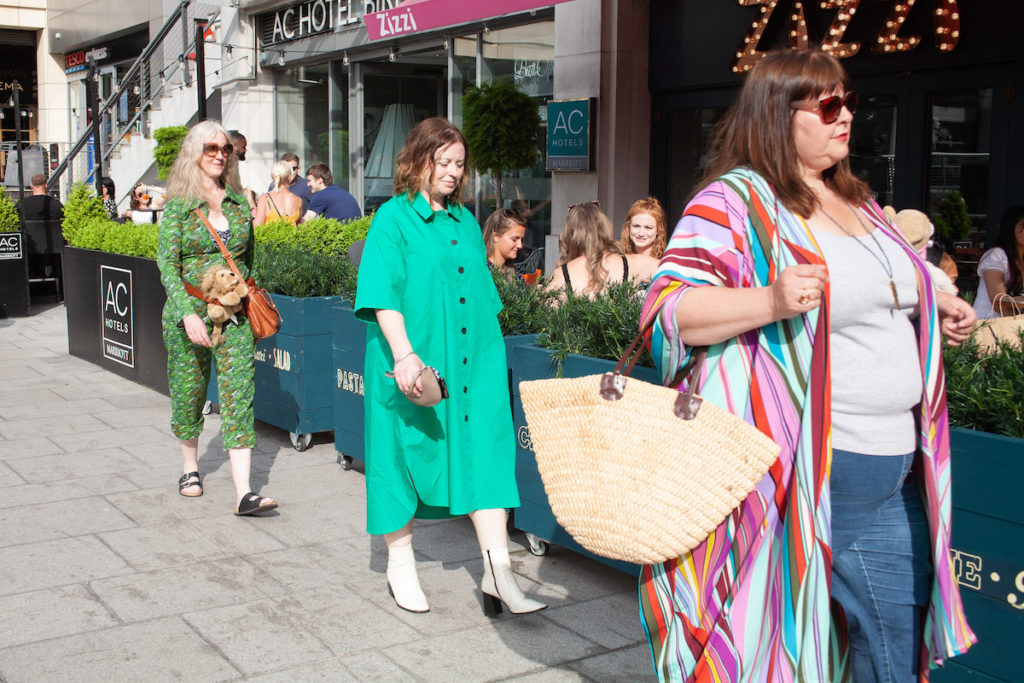
Liz pauses us on the packed terrace above the canal. She later admits she has disliked walking all her life until lockdown equated it with freedom. Here, she is a majestic walk guide, a female crone cult leader in a billowing robe of many colours, stroking her beloved toy cat, and surveying new kingdoms to conquer. Jenny aligns herself next to Liz; she looks serene and confident in the most vivid green dress. I follow in a dinosaur-camouflage boilersuit, with a toy lion stuffed in my belt. I’m wearing a bikini underneath because it’s hot and as a reference to GraceGraceGrace – three gen-age artists who partly inspired this work.
Before us, people are everywhere, enjoying their first freedom in months amid a summer heatwave. Matt runs ahead and crouches down to snap us. This draws attention. The act of photography literally makes us visible – people see him and then look at us. I feel self-conscious but also part of the scene. We may be costumed crones but everyone else is dressed up for high visibility, too. “I love your lion!” shouts a young woman to me as we pass the people-watchers.
On a high metal walkway over the canal junction to Gas St Basin, Liz pauses again. Two women dining at a restaurant beneath are staring up. To give them a better view, we lean on the railings. They look at us, we look at them. They whisper conspiratorially. It doesn’t really matter what they are saying. We are here, we are seen, we are discussed. I’m enjoying this. I almost wave at our whispering younger sisters to let them know we are benevolent but that might break the spell so I resist.
As we approach the canal tunnel to Broad Street and Brindleyplace, a woman now exclaims at Jenny. “OMG I love your dress, I love that green, I could never carry it off!" Seen.
We end the walk at the Ikon art gallery, chosen by Liz as “somewhere all of us will feel safe thanks to our interests and somewhere where it’s entirely acceptable to be dressed unconventionally”. We’ve made it. We are elated. We can’t wait to talk about how it went.
==
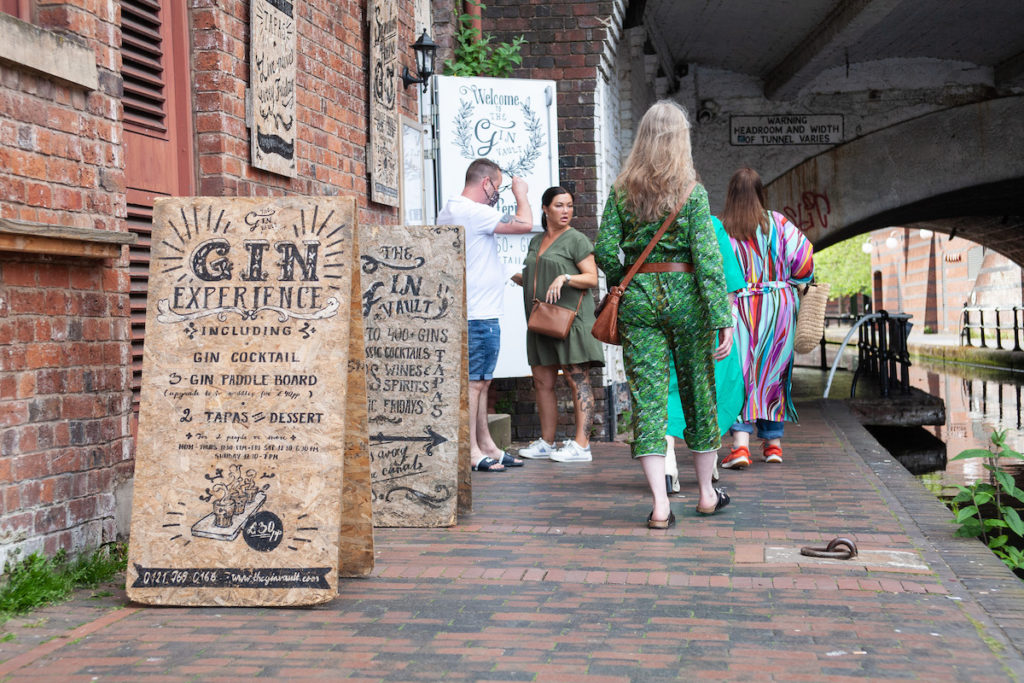
Snapshots
How did it feel? Who did you see? Who is seeing you? Who was missing?
“Like we were gliding through the city, the slow pace, the single file, the deliberate nature of the walk. No one got in our way until the tunnel. It flowed, we flowed.”
“Felt invisible at times – people were busy in their own worlds but it was nice. We could look around and enjoy the city. Our purpose wasn't rushed.”
“The silence was important.”
“There was an urge to smile.”
“Felt quite processionary.”
“Felt benevolent towards my younger self.”
“The standouts were homeless people – wearing black or grey clothes and sitting still.”
“The over-65s, children and normally dressed people were missing from the scene.”
“We blended in – we were in context of everyone else and everyone was dressed up. What would it be like if we went out on a Tuesday or on a morning commute?"
“Did we get into different characters in our minds?” “Not so much. I think it was enough to dress up with intent – as heightened versions of ourselves.”
“I felt a peace from our walk I really did not anticipate.”
“It was a lot of fun! I think there’s something very interesting in an event existing to be photographed and how meaning is created through that process.”
“It felt authentic. That embodied experience once it shifted from sweaty awkwardness to being a part of something was so grounding and liberating.”
==
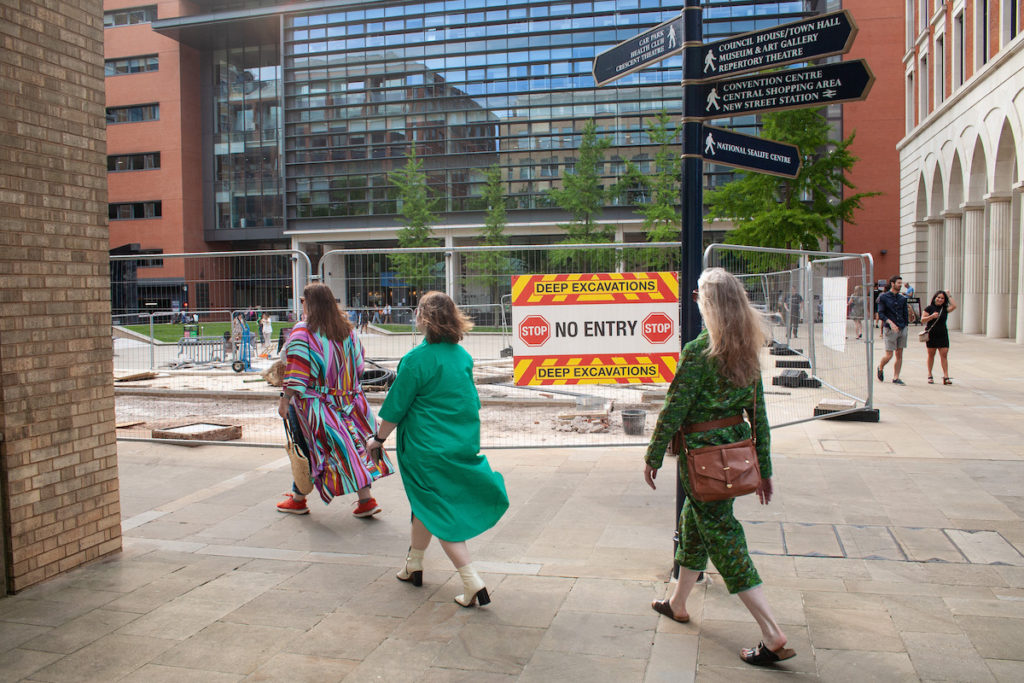
The power of a walk
"I have long been fascinated by how people understand themselves using landscape, by the topographies of self we carry within us and by the maps we make with which to navigate these interior terrains"
– Robert MacFarlane, The Old Ways
“To be a crone is about inner development, not outer appearance”
– Jean Shinoda Bolen, MD and author of ‘Goddesses in Everywoman’
Afterwards it occurs to me that we were mostly seen and acknowledged by women. This fits with losing the male gaze, which was firmly on the maidens of Brindleyplace, but also reflects a lack of older female role models in society. If we could speak to that lack by being more present, it sends a signal that female life doesn’t end when your ovaries switch off.
Our aim was a ‘watched walk’ – to be seen in the city and to claim some space for older women where we had little or no presence. It was a journey that was by degrees self-conscious, eloquent, colourful, conspicuous, fun, celebratory, defiant and bonding. The experience of ‘croning the city’ was more vivid for the participants than the watchers.
Walking as a crone enabled us to think about our own interior worlds of wants and anxieties around gender and ageing. It gave us space to explore where we are at with ageing, what being menopausal means, and how we might see ourselves now and in future.
Taking a stance against encroaching invisibility let us respond to it both individually and as a group. It let us play with cultural stereotypes but also feel the feminine power of coming together after a year of not having such gatherings. And it was fun. The dressing up. The conversation. The chance to get know some funny, smart and intelligent women better.
One surprising factor in the Crone Walk was the photographer. It quickly became clear that the act of photography was not just about documenting the walk but was integral to the work. It facilitated us being seen time and time again.
The photos, when they came, were almost superfluous. Matt’s final selection of 100 photos offered a perfect broad scope of shots from all angles and across all the environments we walked through. But they only provided a singular view – that of the photographer. ‘Croning the City’ was a more intense experience than the photographs could ever show. Walkspace mentor and artist Pete Ashton raised the point that we should be careful not to confuse the art and the documentation. To avoid the photos being seen as the work, the crones decided to publish only one image from the walk (since extended to five images.)
Another surprise… I had thought the Crone Walk would need a leader to make it happen but leadership was also superfluous. In that way that women excel at when they come together, the walk immediately became a collaboration with decisions made by all. It felt good to be part of a group where everyone had an equal voice.
For the record, the collaboration consisted of:
- several pre-walk discussions of what we wanted to do and why, walk practicalities and ‘what is art?’
- an immediate formal post-walk discussion
- an informal post-walk dinner sharing more general experiences around growing older
- a week later, an artist briefing and a group crit of the photos.
There is so often much benefit in how women come together; and in how we walk together too. Walking in a group provided us with a safe space to act. It gave us a sense of solidarity with the changes we are facing as a result of the menopause and a sense of solidarity with others who may also struggle to be heard or seen in society. Through the idea and act of crone walking together, we were able to explore female ageing and take some positive action over it.
==
What next?
‘Croning the City’ turned out to be more than I had hoped for. I hope it won’t be the only crone walk. Perhaps next time we will appear in a different context from a Saturday night out in the city. Perhaps a morning commute or a protest march or walking in other places where crones need to be seen or where our maiden/mother/allies exist.
We could adopt entirely new crone characters or re-invent ourselves for the camera, taking cues from Cindy Sherman’s photographic work. Or maybe it will develop in a completely different way. Into a womanifesto. Or a game. Or a script for a play perhaps.
It doesn't really matter. Ultimately, the crone age is all about potential and change. Crones go through the change. We have the ability to become agents of change.
Bring on The Change.
Bring on the Crone Age.
Bring on the Cronage.
==
Photographs: Matt Murtagh, 2021
